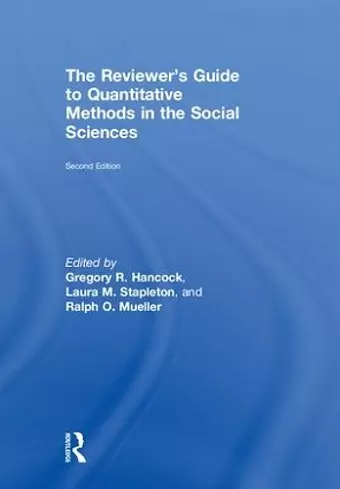The Reviewer’s Guide to Quantitative Methods in the Social Sciences
Ralph O Mueller editor Gregory R Hancock editor Laura M Stapleton editor
Format:Hardback
Publisher:Taylor & Francis Ltd
Published:6th Nov '18
Currently unavailable, and unfortunately no date known when it will be back
This hardback is available in another edition too:
- Paperback£63.99(9781138800137)

The Reviewer’s Guide to Quantitative Methods in the Social Sciences provides evaluators of research manuscripts and proposals in the social and behavioral sciences with the resources they need to read, understand, and assess quantitative work. 35 uniquely structured chapters cover both traditional and emerging methods of quantitative data analysis, which neither junior nor veteran reviewers can be expected to know in detail. The second edition of this valuable resource updates readers on each technique’s key principles, appropriate usage, underlying assumptions and limitations, providing reviewers with the information they need to offer constructive commentary on works they evaluate. Written by methodological and applied scholars, this volume is also an indispensable author’s reference for preparing sound research manuscripts and proposals.
Updated and even more useful, this much-needed volume fills a gap for review consultation and instructional purposes. Highly recommended!
Michael G. Vaughn, Saint Louis University
The first edition of this book belongs on every reviewer’s bookshelf. The second edition is even better and covers topics missed in the first.
David L. Streiner, McMaster University
As an editor for more than 20 years, I had long wrestled with what graduate students and reviewers need to understand and address when evaluating the quality of the quantitative analyses reported in manuscripts. That problem is made even more frustrating by the range of quantitative methods populating the educational research literature. Thanks to this outstanding volume those nagging concerns have largely been put to rest. What these respected editors have compiled are 35 insightful chapters, each devoted to a particular quantitative method and written by an acknowledged expert. Each chapter not only succinctly overviews a given technique, but also delineates the musts and shoulds of its reporting, which are summarized in an easily referenced table. I plan to make this essential guide required reading for all my graduate students and for every editorial board member.
Patricia A. Alexander, Jean Mullan Professor of Literacy, Distinguished Scholar-Teacher, University of Maryland. Senior Editor, Contemporary Educational Psychology
Greg Hancock and his colleagues have done it again. The second edition of TheReviewer’s Guide to Quantitative Methods in the Social Sciences offers 35 chapters written by top-of-the line quantitative researchers who inspire, instruct, and illuminate. The chapters provide key information that is essential in evaluating a wide swath of methods including basic and multivariate statistics, research design, statistical inference procedures, psychometrics, latent variable methods, modeling and more. Every social scientist would benefit from this gem of a volume that cannot help but leave readers more informed, enlightened, and empowered
Lisa L. Harlow, Professor of Psychology, University of Rhode Island
The Reviewer’s Guide to Quantitative Methods in the Social Sciences, Second Edition, is an essential resource for editors, reviewers, researchers, and graduate students who desire to produce and disseminate accurate and meaningful quantitative research. Each of the 35 chapters provides a comprehensive overview of a particular aspect of quantitative study design and/or analytic technique, indicating where (within a research report) and how critical information should be conveyed. Of particular value are the recommendations for appropriate language to use in describing and interpreting quantitative findings, including admonitions against common reporting fallacies, gaps, and other improprieties. It goes without saying that all editors and reviewers should consult this authoritative guide as a de facto set of rigorous standards for evaluating quantitative inquiry, and emerging researchers would benefit tremendously from working with these insightful chapters as they develop a fundamental understanding of designing, conducting, and reporting their work.
John Norris, Senior Research Director, Educational Testing Service
This book is not only of immense value to reviewers, but also a great help to academic writers developing an adequate account of their research outcomes and striving for accountability and transparancy. In 35 chapters (of which 5 are new to the 2nd edition) experts introduce in a very systematic way a large array of methodological techniques, ranging from well-known statistical analyses to more recent advanced ones, from design issues to psychometric analyses. All chapters are centered around a discussion of the desiderata or key elements that are required for a proper report of the technique, even indicating where to put it in a paper, and thus providing convenient evaluation criteria for reviewers and writers alike.
This book is an invaluable reference guide, explaining the issues applied researchers are always wondering about: assumptions, computational options and interpretations.
Rob Schoonen, Professor of Applied Linguistics, Radboud University
ISBN: 9781138800120
Dimensions: unknown
Weight: 1065g
514 pages
2nd edition